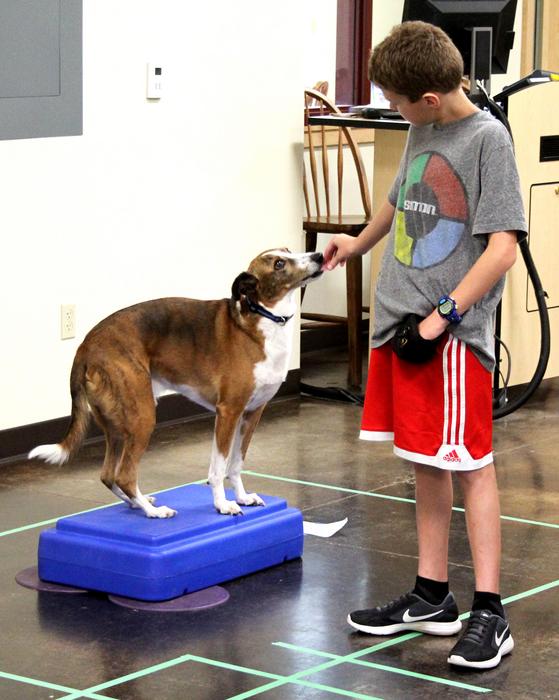Oregon State dog-training program helps increase physical activity among kids with disabilities
CORVALLIS, Ore. — By engaging regularly with their family dog and teaching it a series of tricks and commands, children with developmental disabilities experienced a significant increase in their daily physical activity, a new study from Oregon State University researchers found. Credit: Courtesy Oregon State University CORVALLIS, Ore. — By engaging regularly with their family […]

CORVALLIS, Ore. — By engaging regularly with their family dog and teaching it a series of tricks and commands, children with developmental disabilities experienced a significant increase in their daily physical activity, a new study from Oregon State University researchers found.

Credit: Courtesy Oregon State University
CORVALLIS, Ore. — By engaging regularly with their family dog and teaching it a series of tricks and commands, children with developmental disabilities experienced a significant increase in their daily physical activity, a new study from Oregon State University researchers found.
Children in the experimental group increased their moderate to vigorous physical activity by 17 minutes per day, while simultaneously reducing their sedentary time by nearly an hour per day.
“We often talk about physical activity as just fitness or exercise, but really, it’s about moving and being active on a daily basis,” said study co-author Megan MacDonald, head of OSU’s School of Exercise, Sport, and Health Sciences in the College of Health. “It’s getting out with your dog, playing, having fun.”
Previous research has found that more than 80% of American children are not getting the recommended amount of physical activity — at least 60 minutes per day of moderate to vigorous activity, per the U.S. Department of Health and Human Services — and that overall physical activity declines progressively with age.
Studies have also shown that children with developmental disabilities are significantly less physically active than their peers without disabilities.
“In my opinion, the biggest barrier is just access: access to physical activity from your home, from your community and often from your school. Those are the places we know kids are getting physical activity,” MacDonald said. “But if we want to engage in a sport or activity that’s not inclusive, or that has concerns about adding someone with a disability, that’s an issue. If we have schools that aren’t engaging in inclusive or adaptive physical education — which they are legally required to do — that’s an issue.”
For the current study, published today, MacDonald teamed up with Monique Udell from OSU’s College of Agricultural Sciences. As director of the Human-Animal Interaction Laboratory, Udell’s research includes animal training, human-animal bonding and mutually beneficial interactions.
The team started in 2017 with 45 child-dog pairs, where each child was identified by parents as having some form of developmental disability. The canine participants included a wide range of breeds, ages and previous training experience.
The study revolved around the “Do As I Do” training intervention, in which participants are essentially playing a game of “Simon Says” with their dogs. Pairs in the experimental group received 10 hour-long one-on-one sessions with a dog trainer where they learned about dog body language and behavior, and taught their dogs multiple commands, including the “Do it” command that tells the dog to mimic the behavior their owner has just demonstrated.
“Not all kids got to the final protocol, but what was kind of amazing was that everyone progressed,” MacDonald said. “At the end we had a little showcase, and everyone was able to show something new they could do with their dog.”
Participants assigned to the “active control” group engaged in a dog-walking program for the same amount of time as the Do As I Do program, while kids in the “waitlist control” group did not participate in any guided physical activity with their dogs.
All children were fitted with accelerometers to record their physical activity levels before and after the program. In the end, 14 kids had enough accelerometer data to be included in the results.
Compared with the waitlist control group, children in the Do As I Do training group increased their moderate to vigorous physical activity time by 17.3 minutes per day, and decreased their sedentary time by 58 minutes per day. The group also increased their time spent in light activity by about 40 minutes per day.
An increase of 17 minutes daily amounts to almost 30% of the total recommended time (60 minutes) kids spend in moderate to vigorous physical activity.
“It’s very hard to get significant differences in physical activity; it’s a behavioral thing,” MacDonald said. “So we’re pretty excited about these results.”
And kids are receiving more than just physical benefits, she said. In teaching them to recognize and respond to dogs’ body language, the program also helps kids gain more awareness of nonverbal cues from the people around them.
Training with their family dog also helps build responsibility, independence and a sense of ownership — while, perhaps, giving the parents who are usually responsible for 100% of dog care a much-needed break, MacDonald said.
“It’s one of the coolest studies I’ve worked on,” she said.
OSU co-authors on the study also included Saethra Darling, Duo Jiang, John Schuna and Shelby Wanser.
The team is already working on a similar study with pet cats, and has been doing outreach in the Pacific Northwest with dog trainers, who have shown a lot of interest in becoming involved, MacDonald said.
Journal
Human-Animal Interactions
DOI
10.1079/hai.2024.0009
Method of Research
Experimental study
Subject of Research
People
Article Title
Unleashing potential: Boosting physical activity in children with developmental disabilities via a family-dog-assisted intervention
Article Publication Date
27-Mar-2024
COI Statement
The authors declare that this research was conducted in the absence of any commercial or financial relationships that could be construed as potential conflicts of interest.
What's Your Reaction?

































